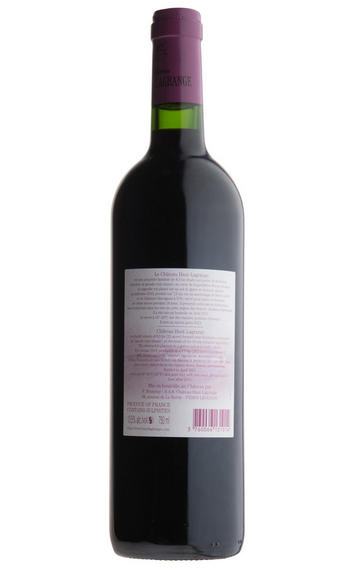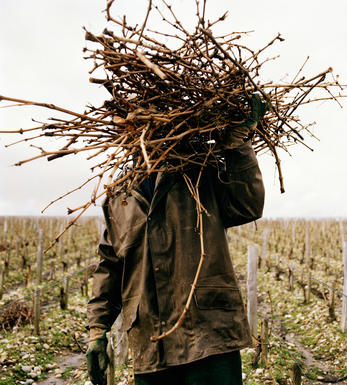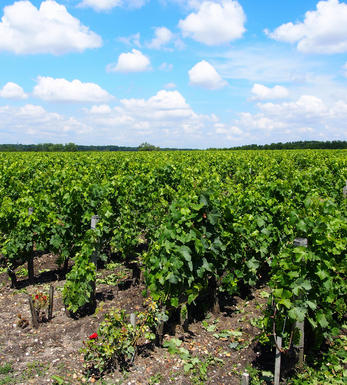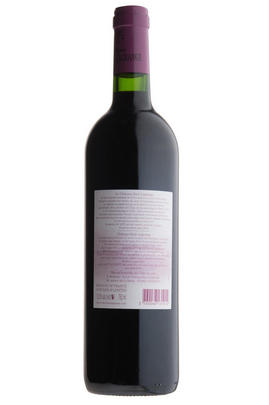
About this WINE

Ch. Haut-Lagrange
The presence of vineyards in that area was established in 1764, although Haut-Lagrange was founded much later on.
The vineyards at Haut-Lagrange have a density of 7,700 feet per hectare, and are now over twenty five years old and have reached their maturity. Two white and two red grape varieties are grown here: Sauvignon Blanc, Semillon, Merlot and Cabernet Sauvignon.
The vines are grown organically, with no chemical pesticides used. Specific equipment is used to conscientiously manage any pest problems, and great care is taken throughout the growing period to ensure a successful harvest and high quality end product.
All the grapes are picked by hand, and then the whites and reds each have their own process to be made into their unique wines.

Pessac-Leognan
In 1986 a new communal district was created within Graves, in Bordeaux, based on the districts of Pessac and Léognan, the first of which lies within the suburbs of the city. Essentially this came about through pressure from Pessac-Léognan vignerons, who wished to disassociate themselves from growers with predominately sandy soils further south in Graves.
Pessac-Léognan has the best soils of the region, very similar to those of the Médoc, although the depth of gravel is more variable, and contains all the classed growths of the region. Some of its great names, including Ch. Haut-Brion, even sit serenely and resolutely in Bordeaux's southern urban sprawl.
The climate is milder than to the north of the city and the harvest can occur up to two weeks earlier. This gives the best wines a heady, rich and almost savoury character, laced with notes of tobacco, spice and leather. Further south, the soil is sandier with more clay, and the wines are lighter, fruity and suitable for earlier drinking.
Recommended Châteaux: Ch. Haut-Brion, Ch. la Mission Haut-Brion, Ch. Pape Clément, Ch Haut-Bailly, Domaine de Chevalier, Ch. Larrivet-Haut-Brion, Ch. Carmes Haut-Brion, Ch. La Garde, Villa Bel-Air.

Cabernet Sauvignon Blend
Cabernet Sauvignon lends itself particularly well in blends with Merlot. This is actually the archetypal Bordeaux blend, though in different proportions in the sub-regions and sometimes topped up with Cabernet Franc, Malbec, and Petit Verdot.
In the Médoc and Graves the percentage of Cabernet Sauvignon in the blend can range from 95% (Mouton-Rothschild) to as low as 40%. It is particularly suited to the dry, warm, free- draining, gravel-rich soils and is responsible for the redolent cassis characteristics as well as the depth of colour, tannic structure and pronounced acidity of Médoc wines. However 100% Cabernet Sauvignon wines can be slightly hollow-tasting in the middle palate and Merlot with its generous, fleshy fruit flavours acts as a perfect foil by filling in this cavity.
In St-Emilion and Pomerol, the blends are Merlot dominated as Cabernet Sauvignon can struggle to ripen there - when it is included, it adds structure and body to the wine. Sassicaia is the most famous Bordeaux blend in Italy and has spawned many imitations, whereby the blend is now firmly established in the New World and particularly in California and Australia.



Buying options
Add to wishlist
Description
The 2010 Ch. Haut-Lagrange is an ambitious effort, offering a dense, opulent style in synch with the vintage’s character. A blend of 45 percent Merlot and 55 percent Cabernet Sauvignon, deep crimson at its core, with a lighter purple rim. This is a modern style of Pessac, and is more obviously fruity than one might expect of the appellation. Gloriously ripe, with delicious blackberry fruit on nose and palate. Soft, integrated tannins and a lush, opulent finish. Drink now to 2017.
wine at a glance
Delivery and quality guarantee